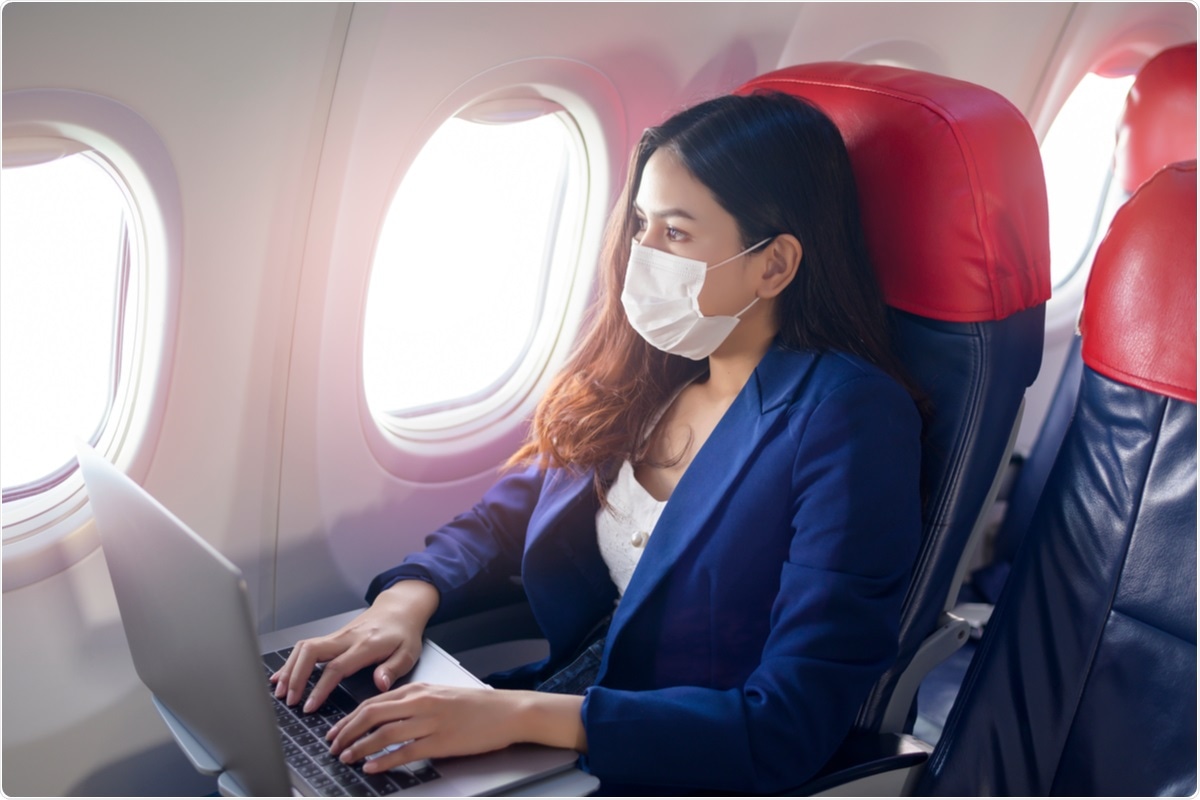Researchers assess SARS-CoV-2 transmission risk during air travel
A team of scientists from the United States recently conducted a meta-analysis to estimate the risk of severe acute respiratory syndrome coronavirus 2 (SARS-CoV-2) infection during air travel. The findings reveal that even with SARS-CoV-2-infected persons onboard, the risk of viral transmission is low inside an aircraft. The study is currently available on the medRxiv* preprint server.

Background
As of April 15, 2021, globally, there have been 136 million confirmed cases of coronavirus disease 2019 (COVID-19), including 2.9 million deaths, registered to the World Health Organization (WHO). At the initial phase of the pandemic, strict control measures applied to control the viral transmission have severely impacted the socioeconomic status of many countries globally. Because of national and international travel restrictions, the aviation industries have faced an almost 95% drop in passenger numbers during the initial phase of the pandemic.
As the pandemic progresses, the aviation-related services of many countries have been resumed to boost the global economy. This gives rise to global concerns about the risk of SARS-CoV-2 transmission among passengers traveling by air across the globe.
Viral transmission due to air travel can occur in two ways. A passenger with SARS-CoV-2 infection traveling via aircraft to a new location can transmit COVID-19 either on the ground or inside the aircraft.
In the current study, the scientists estimated the risk of SARS-CoV-2 transmission from an infected person to fellow passengers inside an aircraft.
Study design
The scientists conducted a systemic review of the present literature to estimate the number of index patients and secondary COVID-19 cases related to air travel between January 2020 and September 2020. An index patient refers to a passenger who was infected before air travel. A secondary COVID-19 case refers to the passenger who became infected from the index patient during air travel.
Because the primary focus of most of the published studies was infected passengers, the current risk estimation was limited to flights with index patients and did not involve the transmission risks among aircrew, ground crews, and airport staff.
The scientists estimated the risk of viral transmission using a quantitative approach that considered secondary cases and the total number of passengers inside an aircraft. The data collected from published literature were corrected for known data limitations, such as asymptomatic and underreported COVID-19 cases. Moreover, because COVID-19 testing and reporting processes vary across different locations/countries, uncertainties were also included in the risk calculation to obtain the most accurate risk estimation.
Important observations
According to the study findings, about 1.4 billion passengers traveled by air between January 2020 and September 2020. Among all air travelers, 2,866 were identified as index patients, and 44 were identified as potential secondary COVID-19 cases.
For estimating the risk of transmission during air travel, the scientists hypothesized that all possible transmissions occurred inside the aircraft cabin; however, they mentioned that in some cases, the transmission could have occurred elsewhere, such as in the airport.
Available literature on in-flight transmission
In a London-Hanoi flight on March 2, 2020, 15 secondary COVID-19 cases were identified. However, based on the duration between flight arrival and a positive SARS-CoV-2 test result, the scientists hypothesized that all these passengers were infected after the completion of air travel.
Furthermore, in a Singapore to Hangzhou, China flight on January 24, 2020, 15 index patients and only a single secondary COVID-19 case were identified. With further analysis, the scientists observed that except for eating food and drinking water, all 16 passengers wore masks throughout the air travel. However, the secondary case did not wear a mask properly when sitting in an unassigned seat surrounded by infected symptomatic passengers.
Estimated risk of in-flight transmission
By including all data correction factors in the calculations, the scientists estimated that the risk of SARS-CoV-2 transmission inside an aircraft cabin is 1 in 1.7 million. Furthermore, using the uncertainty estimates of publicly available literature, they estimated that the risk of in-flight transmission ranges from 1 case in every 712,000 passengers to 1 case in every 8 million passengers.
Study significance
The study reveals that the risk of SARS-CoV-2 transmission inside an aircraft cabin is as low as 1 case in 1.7 million passengers. In other words, the study findings indicate that even with index patients onboard, the overall risk of acquiring secondary infection is low during air travel.
Improved environmental control measures inside an aircraft cabin, such as high airflow, high-quality air purification, and seating arrangements, are believed to play a significant role in reducing the risk of viral transmission among passengers.
*Important Notice
medRxiv publishes preliminary scientific reports that are not peer-reviewed and, therefore, should not be regarded as conclusive, guide clinical practice/health-related behavior, or treated as established information.
- Pang JK. 2021. Probability and Estimated Risk of SARS-CoV-2 Transmission in the Air Travel System: A Systemic Review and Meta-Analysis. MedRxiv. doi: https://doi.org/10.1101/2021.04.08.21255171, https://www.medrxiv.org/content/10.1101/2021.04.08.21255171v1
Posted in: Medical Science News | Medical Research News | Disease/Infection News | Healthcare News
Tags: Coronavirus, Coronavirus Disease COVID-19, Pandemic, Respiratory, SARS, SARS-CoV-2, Severe Acute Respiratory, Severe Acute Respiratory Syndrome, Syndrome

Written by
Dr. Sanchari Sinha Dutta
Dr. Sanchari Sinha Dutta is a science communicator who believes in spreading the power of science in every corner of the world. She has a Bachelor of Science (B.Sc.) degree and a Master's of Science (M.Sc.) in biology and human physiology. Following her Master's degree, Sanchari went on to study a Ph.D. in human physiology. She has authored more than 10 original research articles, all of which have been published in world renowned international journals.
Source: Read Full Article
